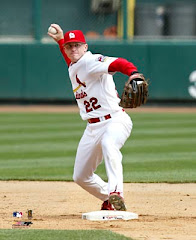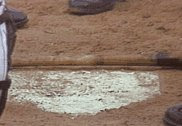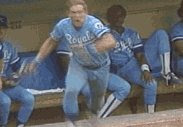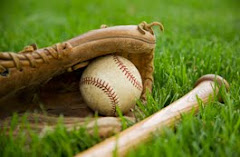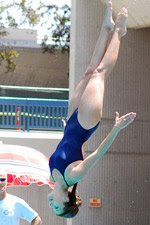Rawlings is about to introduce its newest batting helmet, the S100, a bulkier but far more protective helmet that can withstand the impact of a 100-m.p.h. fastball, according to Rawlings and an independent testing organization. Most other models, when hit flush by a ball, are compromised at speeds in excess of 70 m.p.h. As helpful as the new helmet may be, there is resistance to it from some major league players who are not prepared to sacrifice comfort and style for added protection.
Three weeks after absorbing the potentially deadly impact of a 93-mile-per-hour fastball on his batting helmet, Edgar Gonzalez still feels dizzy whenever he lies down. Because of the lingering effects of a concussion, Gonzalez, a second baseman for the San Diego Padres, has not played since that experience. When he finally returns, it may be with the newest protective device, one that could one day come to define the look of a major league batter. “After this happened to me, I would wear anything,” he said. “I don’t care how goofy it is, as long as it could help protect me.”
Athletics infielder Nomar Garciaparra said, “I want a helmet that’s comfortable, and that doesn’t look bad.”
”Yankee first baseman Mark Teixeira said the new helmet would make him feel as if he were wearing a football helmet in the batter’s box. “The one I’ve used for my entire career is fine,” he said.
It will be hard to predict the number of professionals who will convert to using the new helmet as Major league players are a fearless and traditional bunch. For many, any kind of change (even for the sake of safety) is anathema. I think the Mets third baseman David Wright, who last week dodged a Brad Thompson fastball traveling on a frightening vector toward his head, summed it up best: “I’m not worried about style or looking good out there. I’m worried about keeping my melon protected.”
Tuesday, August 25, 2009
Monday, August 17, 2009
Recession Squeezes Everyone
Coaching stipends are being slashed. Vice principals are being forced to double as athletic directors. Trainers' salaries are being eliminated - And that's just in the Manhattan Beach Unified School District. The sagging economy is pummeling high school athletic departments throughout Southern California, with nearly every school being hit in some way.
In the Long Beach Unified School District, most high schools will experience additional cuts in site budgets for the 2009-10 school year. This will increase the need to rely more on the fund raising efforts of boosters clubs, parents and student athletes who are already giving extra time, energy and dollars to keep sport programs running at a high level. Additionally, the Board of Education adopted a resolution on June 16 that preserved its ability to reduce employee compensation in 2009-10 if necessary.
"It's a bad deal for everybody," said Thom Simmons, a spokesman for the California Interscholastic Federation's Southern Section, the governing athletic body for 571 local schools. "When tax revenue is down, the level of services has to go down. And any time you have to cut services, whether it's for drama, band or athletics, it's just a bad deal."
High schools are not the only institutions to feel the pinch of the economy in athletics. It is being implemented at every level. UCLA Athletic Director Dan Guerrero said, "With the state -- and their university -- struggling through difficult economic times; that He, UCLA football Coach Rick Neuheisel and head basketball Coach Ben Howland have agreed to take pay cuts of 10% this year.
The three men volunteered to take cuts that were mandated for other state employees even though, because they have multi-year contracts, they were not subject to a reduction. Neuheisel was hired in December 2007 for $1.25 million a season and incentives that could add $500,000 a year. Howland received salary and incentives last year totaling $2.17 million. Guerrero recently had his base salary raised to $465,000. Needing to slash his annual budget, the athletic director said he was looking for additional areas to save. "We haven't yet approached other coaches," he said. "But we will."
How did we get to this point? What's next? Thank you to all of you who have done more with less for so many years. Fight the good fight. May the force be with you always.
In the Long Beach Unified School District, most high schools will experience additional cuts in site budgets for the 2009-10 school year. This will increase the need to rely more on the fund raising efforts of boosters clubs, parents and student athletes who are already giving extra time, energy and dollars to keep sport programs running at a high level. Additionally, the Board of Education adopted a resolution on June 16 that preserved its ability to reduce employee compensation in 2009-10 if necessary.
"It's a bad deal for everybody," said Thom Simmons, a spokesman for the California Interscholastic Federation's Southern Section, the governing athletic body for 571 local schools. "When tax revenue is down, the level of services has to go down. And any time you have to cut services, whether it's for drama, band or athletics, it's just a bad deal."
High schools are not the only institutions to feel the pinch of the economy in athletics. It is being implemented at every level. UCLA Athletic Director Dan Guerrero said, "With the state -- and their university -- struggling through difficult economic times; that He, UCLA football Coach Rick Neuheisel and head basketball Coach Ben Howland have agreed to take pay cuts of 10% this year.
The three men volunteered to take cuts that were mandated for other state employees even though, because they have multi-year contracts, they were not subject to a reduction. Neuheisel was hired in December 2007 for $1.25 million a season and incentives that could add $500,000 a year. Howland received salary and incentives last year totaling $2.17 million. Guerrero recently had his base salary raised to $465,000. Needing to slash his annual budget, the athletic director said he was looking for additional areas to save. "We haven't yet approached other coaches," he said. "But we will."
How did we get to this point? What's next? Thank you to all of you who have done more with less for so many years. Fight the good fight. May the force be with you always.
Tuesday, August 4, 2009
Meggs Named New UW Baseball Coach
SEATTLE - After three years spent building the Indiana State baseball team into a winning program, Lindsay Meggs returns to the West Coast as he has been named the new head baseball coach at the University of Washington, athletic director Scott Woodward announced today.
Meggs, 46, who won two NCAA Division II national titles while at Chico State, served as the Indiana State head coach for the 2007, 2008 and 2009 seasons. This past year, he was named Missouri Valley Conference Coach of the Year after leading Indiana State to a 33-21 overall record and a 15-7 mark in MVC play, good enough to earn the No. 2 seed in the conference tournament.
Prior to his 13 seasons in Chico, Meggs was head coach at Long Beach City College for three seasons, going 75-51-1 with three trips to the playoffs during his term with the Vikings. He was also head coach at Oxnard College (1989-90) and was an assistant coach at Cal Lutheran (1988-89) and De Anza Junior College (1987-88)
Congratulations to coach Meggs and the Washington Huskies.
Aug 4, 2009 ... Well, the Huskies once again have made a statement with the addition of San Francisco assistant coach and recruiting coordinator Greg Moore. GIARRATANO ON MOORE: "Greg has emerged as one of the nation's elite after having two quality left-handed pitchers that were undrafted after high school, go in the first round.(Aaron Poreda and Evan Fredrickson) We wish him all the best."
Gregg, a product of Millikan High School and LBCC is a tireless recruiter and excellent talent evaluator. He will make an immediate impact at UW. Congratulations to Gregg....another Viking makes good.
Meggs, 46, who won two NCAA Division II national titles while at Chico State, served as the Indiana State head coach for the 2007, 2008 and 2009 seasons. This past year, he was named Missouri Valley Conference Coach of the Year after leading Indiana State to a 33-21 overall record and a 15-7 mark in MVC play, good enough to earn the No. 2 seed in the conference tournament.
Prior to his 13 seasons in Chico, Meggs was head coach at Long Beach City College for three seasons, going 75-51-1 with three trips to the playoffs during his term with the Vikings. He was also head coach at Oxnard College (1989-90) and was an assistant coach at Cal Lutheran (1988-89) and De Anza Junior College (1987-88)
Congratulations to coach Meggs and the Washington Huskies.
Aug 4, 2009 ... Well, the Huskies once again have made a statement with the addition of San Francisco assistant coach and recruiting coordinator Greg Moore. GIARRATANO ON MOORE: "Greg has emerged as one of the nation's elite after having two quality left-handed pitchers that were undrafted after high school, go in the first round.(Aaron Poreda and Evan Fredrickson) We wish him all the best."
Gregg, a product of Millikan High School and LBCC is a tireless recruiter and excellent talent evaluator. He will make an immediate impact at UW. Congratulations to Gregg....another Viking makes good.
Subscribe to:
Posts (Atom)






